LisbonLisboaPortugal.com
The best independent guide to Lisbon
LisbonLisboaPortugal.com
The best independent guide to Lisbon
Feira da Ladra, Lisbon - The flea market of the Alfama district
The Feira da Ladra is a twice-weekly market held on Tuesdays and Saturdays in the Alfama district of Lisbon. The market's name translates to the dubious 'market of the female thieves', but rest assured, it is perfectly safe and an enjoyable experience if you like rummaging through a mix of items and haggling for that one standout find.
The Feira da Ladra is Lisbon's oldest market, with roots dating back to the 13th century. Initially known for selling unwanted items of dubious origin (hence its name), it has transformed into a lively flea market offering a diverse array of items. The varied selection of stalls includes everything from collectibles and vintage clothing to books and antiques.
Today, the Feira da Ladra primarily caters to tourists and provides an enjoyable setting for an early morning browse, where you can search for hidden gems amidst a variety of items.
Related articles: Lisbon’s best markets
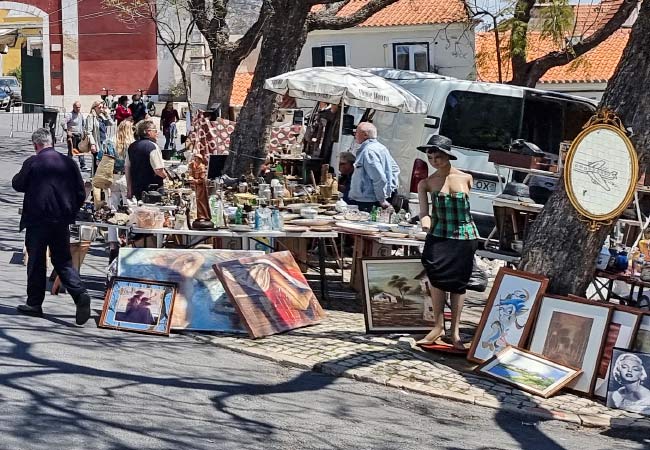
The market contains a wide range of stalls
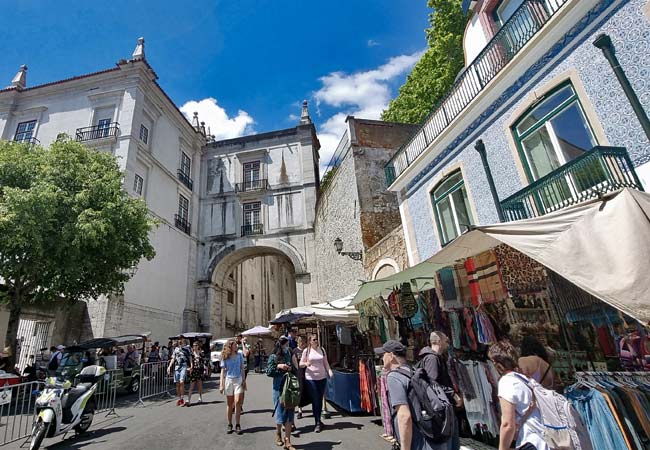
The Feira da Ladra is hosted in the pretty streets of the Alfama district
Feira da Ladra - Tourist information
The market takes place every Tuesday and Saturday, opening at around 8am. The market officially finishes at 2pm, but by late morning (11am), the bargains have gone and all that remains is junk. The Saturday market tends to be busier than Tuesday's market.
The Feira da Ladra is held on the Campo de Santa Clara (GPS: 38.715, -9.124 - link to Google Maps) and is overlooked by the National Pantheon. The closest metro station is Santa Apolónia, which is part of the large intercity train station and the final stop on the blue metro line. From the metro station, head in a northerly direction (away from the River Tejo) and you’ll find the market less than 150 metres away.
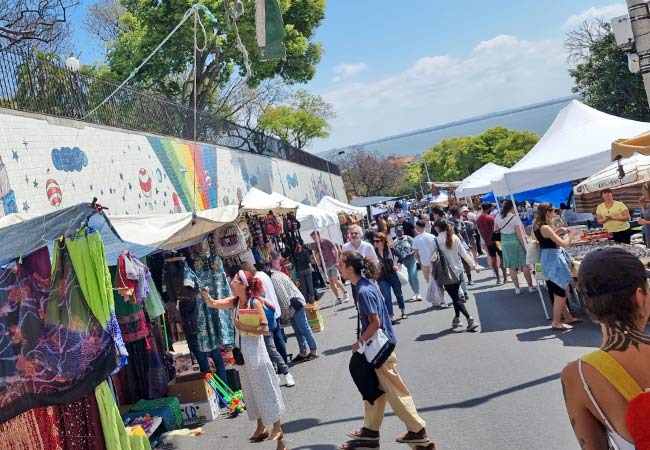
The Feira da Ladra market can get very busy in the summer
If you're planning to buy items from the market, always bring cash, as none of the market stalls accept bank cards.
Despite being a flea market, its renowned reputation means that prices are higher than at typical flea markets. Don’t go expecting bargains; instead, approach it with the intention of discovering unique and distinctive items. If looking at higher-priced items, always be prepared to haggle and refuse the first price quoted.
Warning: Be cautious when buying antique tiles, as they may have been stolen from churches or other historic buildings.
The restaurant Tabernita is the best place for food while at the market, serving delicious traditional Portuguese dishes. However, expect it to be busy when the market is operating.
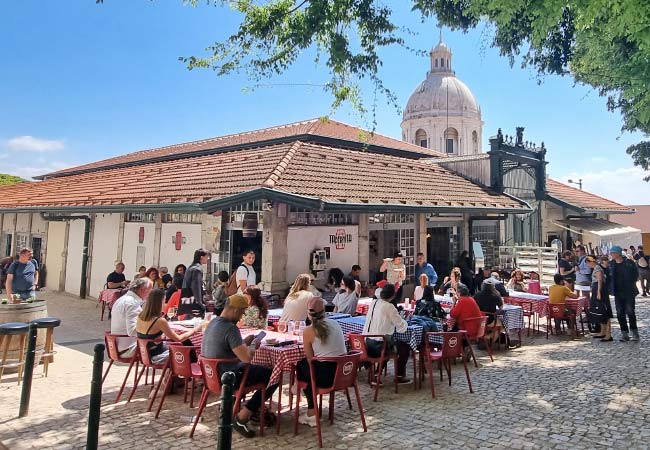
The outside seating of Tabernita
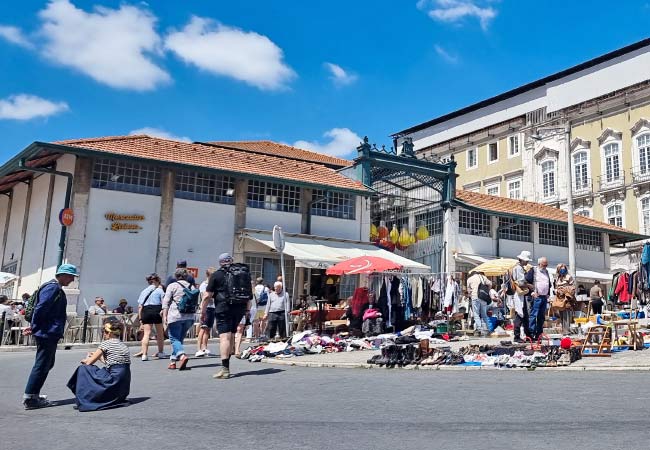
The Mercado de Santa Clara building lies at the heart of the Feira da Ladra market
Feira da Ladra is often translated as ‘thieves market’. However, there is an intriguing theory that the name actually originates from the word ‘ladro’, referring to a flea commonly found in antique furniture. This alternate explanation adds a layer of historical charm to the market's name, reflecting its deep-rooted connection to the world of antiques and vintage goods.
The market's origins date back to the 13th century, but it wasn't until 1882 that the Feira da Ladra settled at the Campo de Santa Clara. Initially held only on Tuesdays, the market has also been taking place on Saturdays since 1903.
A sight that should not be missed while at the market is the 188-metre-long tile mural that extends around the Jardim Botto Machado. This whimsical and colourful mural consists of 52,738 hand-painted tiles and depicts the travels and adventures of the artist André Saraiva's life.
Within the mural are iconic buildings from cities such as New York and Paris, along with many of Lisbon's famous attractions, including the Castelo de São Jorge, the Ponte 25 de Abril, the Elevador de Santa Justa, the Padrão dos Descobrimentos and the Praça de Touros do Campo Pequeno.
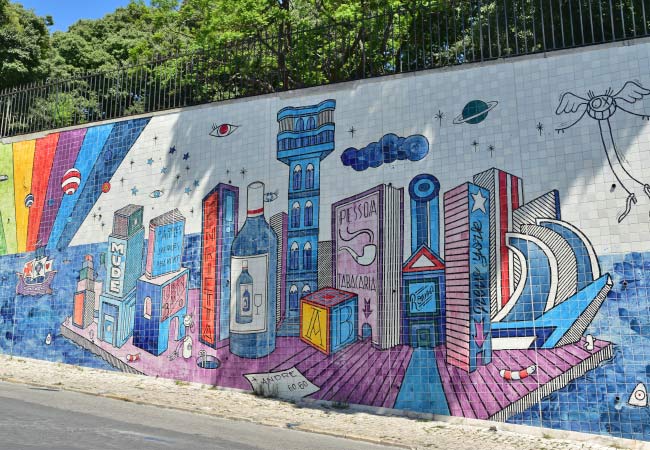
The Elevador de Santa Justa, depicted within the colourful mural.
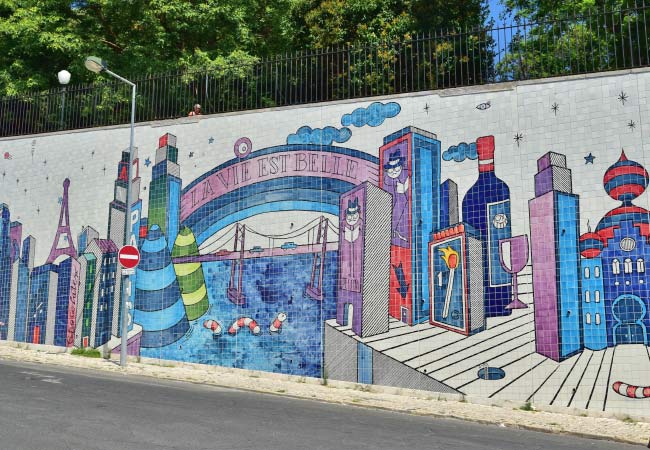
The Mural de Azulejos is best appreciated when the market is not taking place.
Discover more of Lisbon with our guides
If you've found our content valuable, we'd welcome your support.
The digital publishing landscape has evolved significantly. As a small independent publisher, we face growing challenges. Search engines increasingly favour paid content over organic results, while AI-generated content often reproduces original work without attribution.
To support our work, please consider bookmarking this page (press Ctrl + D) for quick access. If you find an article helpful, we'd be grateful if you'd share it with friends on social media.
For specific questions, please see our Reddit community at r/LisbonPortugalTravel.
Should you notice any outdated or incorrect information, please contact us at [email protected]
Thank you for helping us continue to provide valuable content in an increasingly challenging digital environment.
A complete list of all of our Lisbon articles
If you've found our content valuable, we'd welcome your support.
The digital publishing landscape has evolved significantly. As a small independent publisher, we face growing challenges. Search engines increasingly favour paid content over organic results, while AI-generated content often reproduces original work without attribution.
To support our work, please consider bookmarking this page (press Ctrl + D) for quick access. If you find an article helpful, we'd be grateful if you'd share it with friends on social media.
For specific questions, please see our Reddit community at r/LisbonPortugalTravel.
Should you notice any outdated or incorrect information, please contact us at [email protected]
Thank you for helping us continue to provide valuable content in an increasingly challenging digital environment.



































